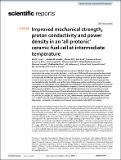Improved mechanical strength, proton conductivity and power density in an ‘all-protonic’ ceramic fuel cell at intermediate temperature
Abstract
Protonic ceramic fuel cells (PCFCs) have become the most efficient, clean and cost-effective electrochemical energy conversion devices in recent years. While significant progress has been made in developing proton conducting electrolyte materials, mechanical strength and durability still need to be improved for efficient applications. We report that adding 5 mol% Zn to the Y-doped barium cerate-zirconate perovskite electrolyte material can significantly improve the sintering properties, mechanical strength, durability and performance. Using same proton conducting material in anodes, electrolytes and cathodes to make a strong structural backbone shows clear advantages in mechanical strength over other arrangements with different materials. Rietveld analysis of the X-ray and neutron diffraction data of BaCe0.7Zr0.1Y0.15Zn0.05O3−δ (BCZYZn05) revealed a pure orthorhombic structure belonging to the Pbnm space group. Structural and electrochemical analyses indicate highly dense and high proton conductivity at intermediate temperature (400–700 °C). The anode-supported single cell, NiO-BCZYZn05|BCZYZn05|BSCF-BCZYZn05, demonstrates a peak power density of 872 mW cm−2 at 700 °C which is one of the highest power density in an all-protonic solid oxide fuel cell. This observation represents an important step towards commercially viable SOFC technology.
Citation
Azad , A K , Abdalla , A M , Afif , A , Azad , A , Afroze , S , Idris , A C , Park , J-Y , Saqib , M , Radenahmad , N , Hossain , S , Elius , I B , Al-Mamun , M , Zaini , J , Al-Hinai , A , Reza , M S & Irvine , J T S 2021 , ' Improved mechanical strength, proton conductivity and power density in an ‘all-protonic’ ceramic fuel cell at intermediate temperature ' , Scientific Reports , vol. 11 , 19382 . https://doi.org/10.1038/s41598-021-98987-6
Publication
Scientific Reports
Status
Peer reviewed
ISSN
2045-2322Type
Journal article
Description
The authors AA and NR would like to thank Universiti Brunei Darussalam for providing a UGS scholarship to perform this research. This work was supported by the UBD CRG project: UBD/OVACRI/CRGWG(006)/161201.Collections
Items in the St Andrews Research Repository are protected by copyright, with all rights reserved, unless otherwise indicated.

